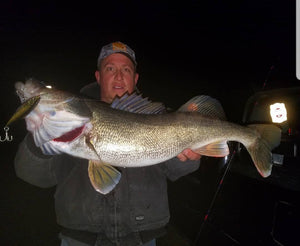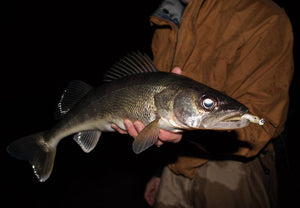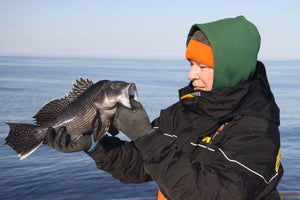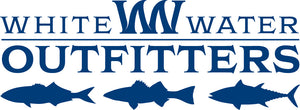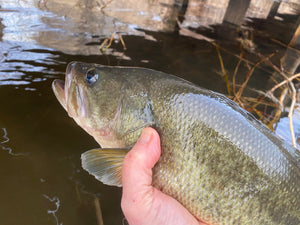Time The Tides, Slow Down for Hot Summer Scores
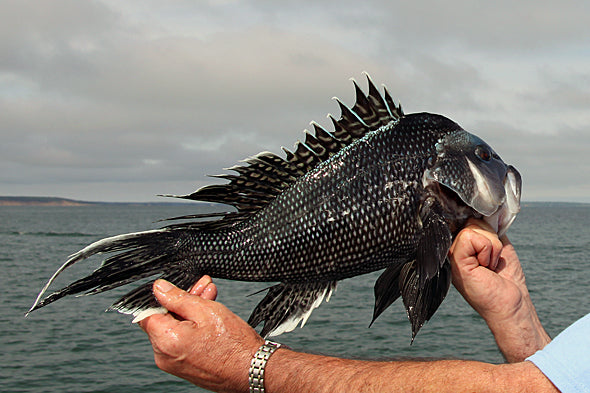
Black sea bass are a summer favorite, especially on nearshore wrecks and reefs. A slow jigging motion along the bottom can rack up some great scores with clam baits, squid strips or a lightweight diamond jig. OutdoorTom.com photo.
Looks like we’re off to another scorching summer here on Long Island’s East End. That should come as little surprise given our sea surface water temperatures have been rising incrementally for years now. While we are nowhere close to threatening surprising 101.1° surface temperature recorded in the backwater shallows of Key Largo’s Manatee Bay on July 24, 2023, there’s little doubt warmer waters in our own backyard means some adjustments may be needed to keep your scores respectable over the next two months.
Interestingly, our summer species continue to feed fairly well most summers, with some sharpies recording solid catches even during the fiercest of heat spells. Part of that may be due to experienced anglers having a solid understanding of favorable local geography. Shinnecock and Moriches bays, for example, receive a nice influx of cooler ocean water through their inlets on incoming tides. That water rushing into the bays can be as much as 5-degrees cooler than what you’ll find on the flats and in the shallow channels in these waters, and it can surely trigger a freshened bite. The Peconics also get a respite from max water temperatures from an influx of cooler Gardiner’s Bay water on rising tides.
Smart anglers double-down on such favorable conditions, concentrating mid-summer efforts on the flood realizing that refreshing incoming water often triggers the best action of the day. Rising water that tops out before 9 a.m. or an hour prior to sunset can be especially valuable as they buoy the refreshing coolness of the day’s lowest temperatures at points when the summer sun is least intense. Continuing on that theme, night fishing is also worthy of consideration, especially if stripers are the target. Fish a strong rising tide on the graveyard shift from the surf or close to an inlet and the bite can be surprisingly reliable even through August.
 Sometimes smaller and slimmer is better. This is often the case with fluke when water temperatures reach high levels. OutdoorTom.com photo.
Sometimes smaller and slimmer is better. This is often the case with fluke when water temperatures reach high levels. OutdoorTom.com photo.
Peconic Bay sharpies also benefit greatly from their knowledge of deeper waters. Stretching east from Jessup Neck on the south side and Jennings Point on the north, a little chart research will turn up multiple holes exceeding 30-feet in depth, along with a few cuts and pockets that can dip down to 50 or even 100-plus feet. When the going gets hot, fish can stack up in the cooler deep waters along these slopes. To make the most of these limited haunts, however, you may need to beef-up your bay tackle since six- to 10-ounce sinkers can be required to hold bottom once the tides gets pushing. Something along the lines of a JW-OX701C-H Jigging World Onyx casting rod matched to a Daiwa Saltist 15 reel loaded with 20- to 30-pound braid should work just fine.
Of course, another way to beat the heat is to pass on the bays completely and push out into nearshore ocean waters where you can work rubble, wrecks and reefs for bottom huggers in comparatively deep water that ensures your baits, jigs, bucktails and other offerings spend their time in the coolest waters around. If you have the means to get outside the inlets, this option obviously makes a lot of sense.
Keep in mind, too, that fish metabolisms slow down during the heat of summer. That equates to less aggressive bites, a problem that can be somewhat remedied by scaling down the profile and length of the lures you throw this time of year. While the old adage “big baits catch big fish” may apply more often than not in the spring and fall, a slower retrieve and smaller target is likely to interest sluggish summer combatants that are reluctant to play, especially in shallower waters. Rather than tossing large plugs, big bucktails and heavy metal for stripers, or dragging large strip baits and fat grubs across the bottom for fluke and sea bass, lessen your profiles and you’ll often get a better response. It’s amazing how many species can be fooled with a light bucktail or jighead tipped with a Berkley Gulp!® 5-inch Jerk Shad, 4-inch Swimming Mullet, 4-inch Saltwater Shrimp, or just a single 4- to 6-inch pennant of squid. A ¾- to 1.5-ounce tubeless diamond jig, presented on 8 – to 12-pound test braided line, is another great choice when worked with a moderate jigging action that allows it to alternate between bouncing the bottom and rising just a foot or two above the sea floor.
Two additional aspects of mid-summer fishing to keep in mind are the need to stay hydrated and dressed for success. Simply put, it’s vital to carry along plenty of drinking water and sunblock, wear polarized shades for UV eye protection, and take advantage of sun-protective clothing as much as possible. Make certain to reapply sunblock throughout the day, and wear a hat with a large brim if possible. Donning a cooling neck gaiter or sun mask is a smart idea, too. We carry a variety of protective sun-wear at the shop and online should you need it.
- Bryce Poyer

